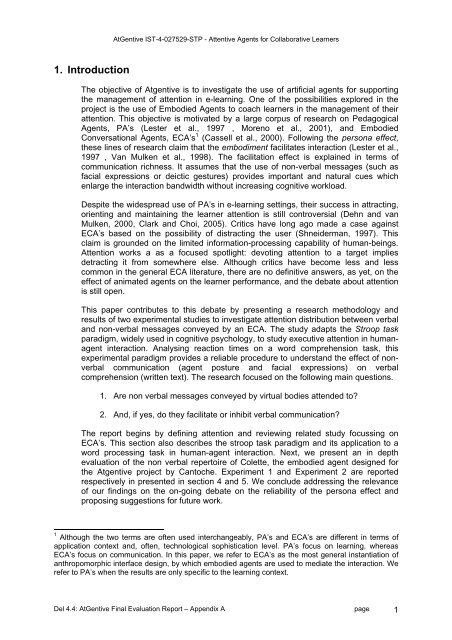Deliverable 4.4 - INSEAD CALT
Deliverable 4.4 - INSEAD CALT
Deliverable 4.4 - INSEAD CALT
You also want an ePaper? Increase the reach of your titles
YUMPU automatically turns print PDFs into web optimized ePapers that Google loves.
AtGentive IST-4-027529-STP - Attentive Agents for Collaborative Learners1. IntroductionThe objective of Atgentive is to investigate the use of artificial agents for supportingthe management of attention in e-learning. One of the possibilities explored in theproject is the use of Embodied Agents to coach learners in the management of theirattention. This objective is motivated by a large corpus of research on PedagogicalAgents, PA’s (Lester et al., 1997 , Moreno et al., 2001), and EmbodiedConversational Agents, ECA’s 1 (Cassell et al., 2000). Following the persona effect,these lines of research claim that the embodiment facilitates interaction (Lester et al.,1997 , Van Mulken et al., 1998). The facilitation effect is explained in terms ofcommunication richness. It assumes that the use of non-verbal messages (such asfacial expressions or deictic gestures) provides important and natural cues whichenlarge the interaction bandwidth without increasing cognitive workload.Despite the widespread use of PA’s in e-learning settings, their success in attracting,orienting and maintaining the learner attention is still controversial (Dehn and vanMulken, 2000, Clark and Choi, 2005). Critics have long ago made a case againstECA’s based on the possibility of distracting the user (Shneiderman, 1997). Thisclaim is grounded on the limited information-processing capability of human-beings.Attention works a as a focused spotlight: devoting attention to a target impliesdetracting it from somewhere else. Although critics have become less and lesscommon in the general ECA literature, there are no definitive answers, as yet, on theeffect of animated agents on the learner performance, and the debate about attentionis still open.This paper contributes to this debate by presenting a research methodology andresults of two experimental studies to investigate attention distribution between verbaland non-verbal messages conveyed by an ECA. The study adapts the Stroop taskparadigm, widely used in cognitive psychology, to study executive attention in humanagentinteraction. Analysing reaction times on a word comprehension task, thisexperimental paradigm provides a reliable procedure to understand the effect of nonverbalcommunication (agent posture and facial expressions) on verbalcomprehension (written text). The research focused on the following main questions.1. Are non verbal messages conveyed by virtual bodies attended to?2. And, if yes, do they facilitate or inhibit verbal communication?The report begins by defining attention and reviewing related study focussing onECA’s. This section also describes the stroop task paradigm and its application to aword processing task in human-agent interaction. Next, we present an in depthevaluation of the non verbal repertoire of Colette, the embodied agent designed forthe Atgentive project by Cantoche. Experiment 1 and Experiment 2 are reportedrespectively in presented in section 4 and 5. We conclude addressing the relevanceof our findings on the on-going debate on the reliability of the persona effect andproposing suggestions for future work.1 Although the two terms are often used interchangeably, PA’s and ECA’s are different in terms ofapplication context and, often, technological sophistication level. PA’s focus on learning, whereasECA’s focus on communication. In this paper, we refer to ECA’s as the most general instantiation ofanthropomorphic interface design, by which embodied agents are used to mediate the interaction. Werefer to PA’s when the results are only specific to the learning context.Del <strong>4.4</strong>: AtGentive Final Evaluation Report – Appendix A page 1
















